Case Study on Auditing Ethics and Inventory Audit Procedures
VerifiedAdded on 2020/05/16
|30
|7771
|323
Case Study
AI Summary
This case study examines professional ethics in auditing, focusing on ethical issues and inventory audit procedures. Part A discusses ethical dilemmas faced by an auditor, Andy, in soliciting clients, including potential conflicts of interest and professional misconduct. It identifies courses of action to address these issues, such as communicating with existing auditors and maintaining independence. Part B details inventory audit procedures, emphasizing key assertions like completeness, accuracy, valuation, rights, and existence. It outlines alternative audit procedures when physical inventory counts are not feasible, such as invoice reconciliation and critical assessment of financial statements. The case underscores the importance of ethical conduct and thorough audit practices in ensuring the true and fair view of financial statements. Desklib provides access to similar solved assignments and past papers for students.
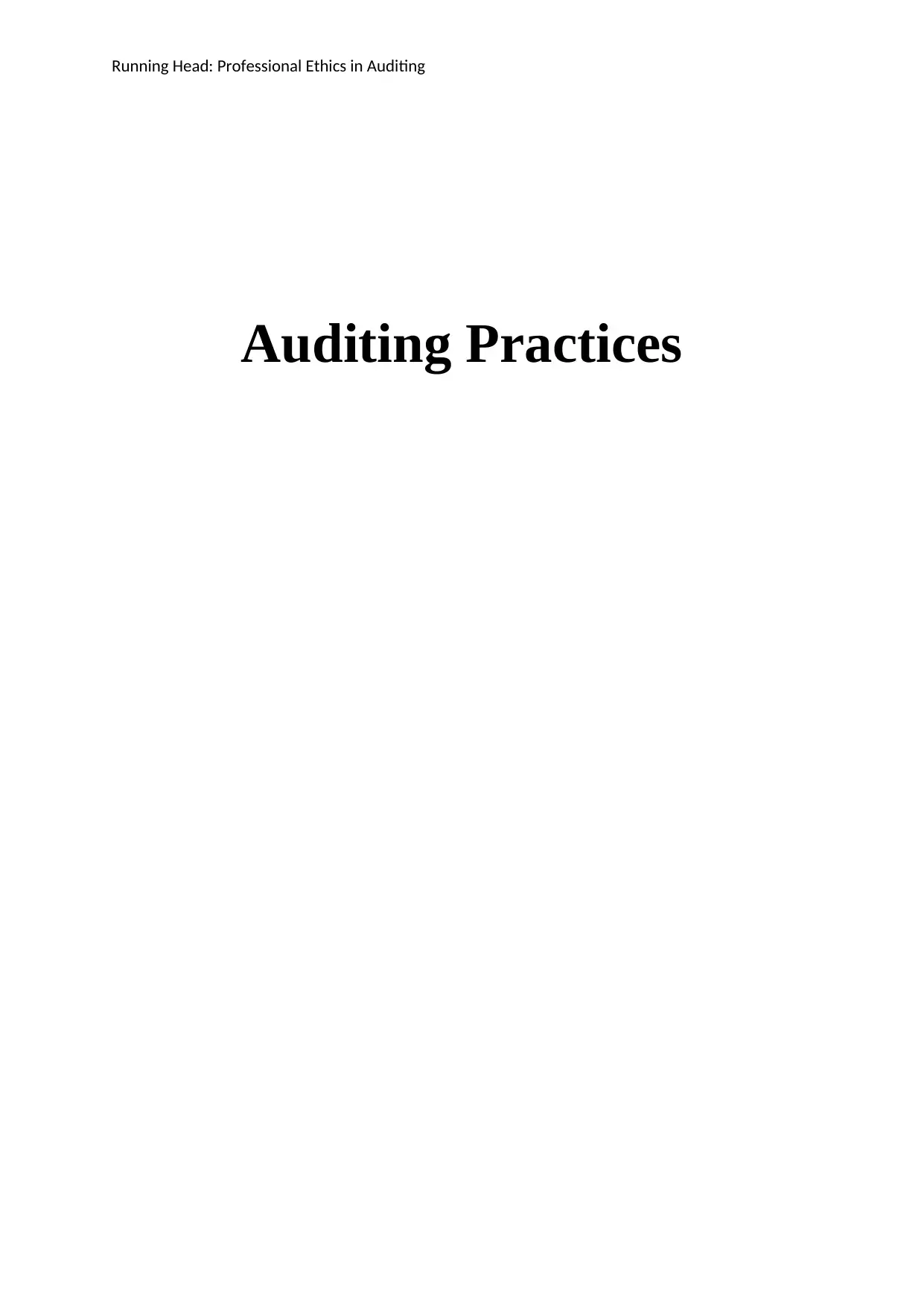
Running Head: Professional Ethics in Auditing
Auditing Practices
Auditing Practices
Paraphrase This Document
Need a fresh take? Get an instant paraphrase of this document with our AI Paraphraser
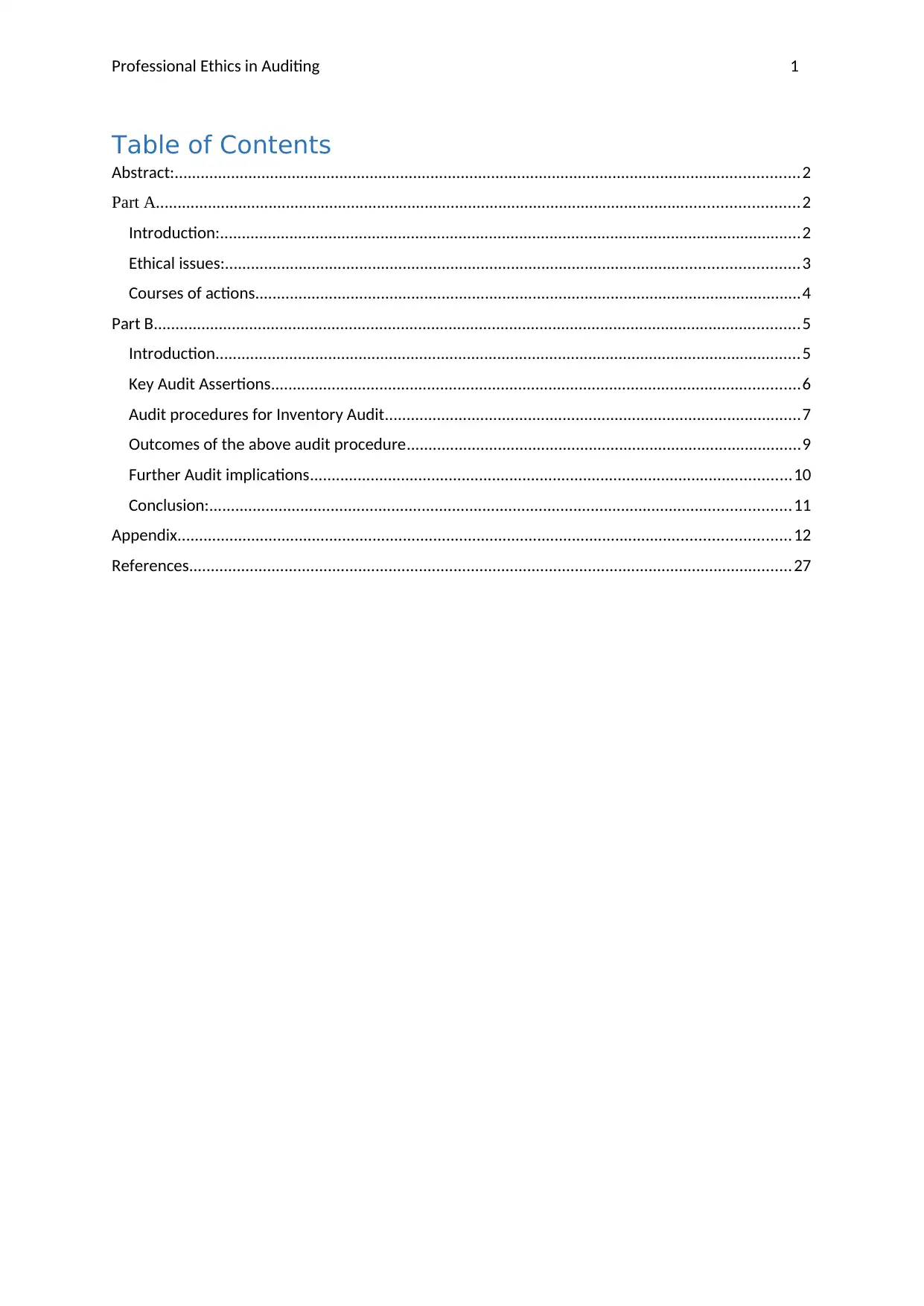
Professional Ethics in Auditing 1
Table of Contents
Abstract:................................................................................................................................................2
Part A....................................................................................................................................................2
Introduction:......................................................................................................................................2
Ethical issues:....................................................................................................................................3
Courses of actions..............................................................................................................................4
Part B.....................................................................................................................................................5
Introduction.......................................................................................................................................5
Key Audit Assertions..........................................................................................................................6
Audit procedures for Inventory Audit................................................................................................7
Outcomes of the above audit procedure...........................................................................................9
Further Audit implications...............................................................................................................10
Conclusion:......................................................................................................................................11
Appendix.............................................................................................................................................12
References...........................................................................................................................................27
Table of Contents
Abstract:................................................................................................................................................2
Part A....................................................................................................................................................2
Introduction:......................................................................................................................................2
Ethical issues:....................................................................................................................................3
Courses of actions..............................................................................................................................4
Part B.....................................................................................................................................................5
Introduction.......................................................................................................................................5
Key Audit Assertions..........................................................................................................................6
Audit procedures for Inventory Audit................................................................................................7
Outcomes of the above audit procedure...........................................................................................9
Further Audit implications...............................................................................................................10
Conclusion:......................................................................................................................................11
Appendix.............................................................................................................................................12
References...........................................................................................................................................27
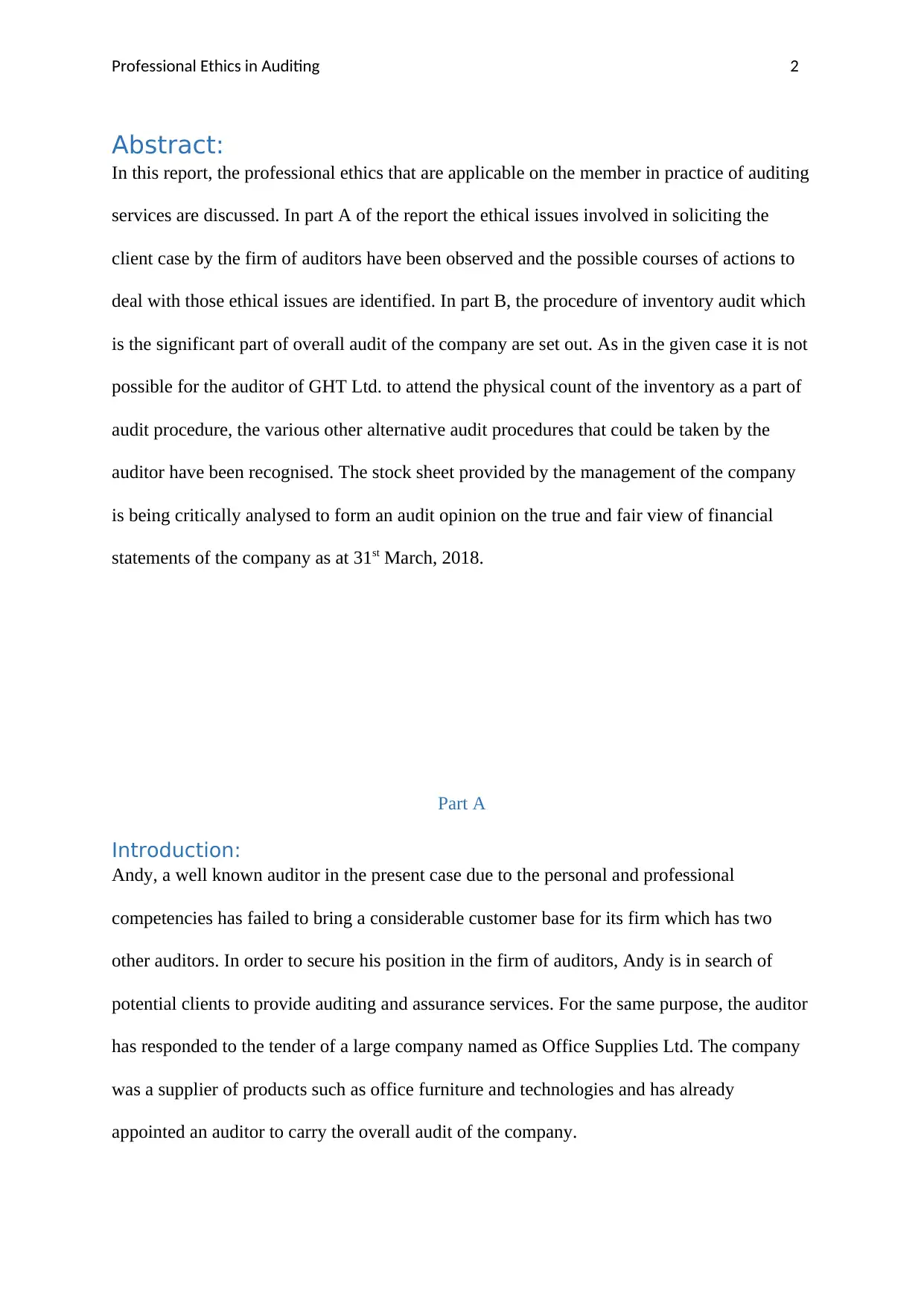
Professional Ethics in Auditing 2
Abstract:
In this report, the professional ethics that are applicable on the member in practice of auditing
services are discussed. In part A of the report the ethical issues involved in soliciting the
client case by the firm of auditors have been observed and the possible courses of actions to
deal with those ethical issues are identified. In part B, the procedure of inventory audit which
is the significant part of overall audit of the company are set out. As in the given case it is not
possible for the auditor of GHT Ltd. to attend the physical count of the inventory as a part of
audit procedure, the various other alternative audit procedures that could be taken by the
auditor have been recognised. The stock sheet provided by the management of the company
is being critically analysed to form an audit opinion on the true and fair view of financial
statements of the company as at 31st March, 2018.
Part A
Introduction:
Andy, a well known auditor in the present case due to the personal and professional
competencies has failed to bring a considerable customer base for its firm which has two
other auditors. In order to secure his position in the firm of auditors, Andy is in search of
potential clients to provide auditing and assurance services. For the same purpose, the auditor
has responded to the tender of a large company named as Office Supplies Ltd. The company
was a supplier of products such as office furniture and technologies and has already
appointed an auditor to carry the overall audit of the company.
Abstract:
In this report, the professional ethics that are applicable on the member in practice of auditing
services are discussed. In part A of the report the ethical issues involved in soliciting the
client case by the firm of auditors have been observed and the possible courses of actions to
deal with those ethical issues are identified. In part B, the procedure of inventory audit which
is the significant part of overall audit of the company are set out. As in the given case it is not
possible for the auditor of GHT Ltd. to attend the physical count of the inventory as a part of
audit procedure, the various other alternative audit procedures that could be taken by the
auditor have been recognised. The stock sheet provided by the management of the company
is being critically analysed to form an audit opinion on the true and fair view of financial
statements of the company as at 31st March, 2018.
Part A
Introduction:
Andy, a well known auditor in the present case due to the personal and professional
competencies has failed to bring a considerable customer base for its firm which has two
other auditors. In order to secure his position in the firm of auditors, Andy is in search of
potential clients to provide auditing and assurance services. For the same purpose, the auditor
has responded to the tender of a large company named as Office Supplies Ltd. The company
was a supplier of products such as office furniture and technologies and has already
appointed an auditor to carry the overall audit of the company.
⊘ This is a preview!⊘
Do you want full access?
Subscribe today to unlock all pages.

Trusted by 1+ million students worldwide
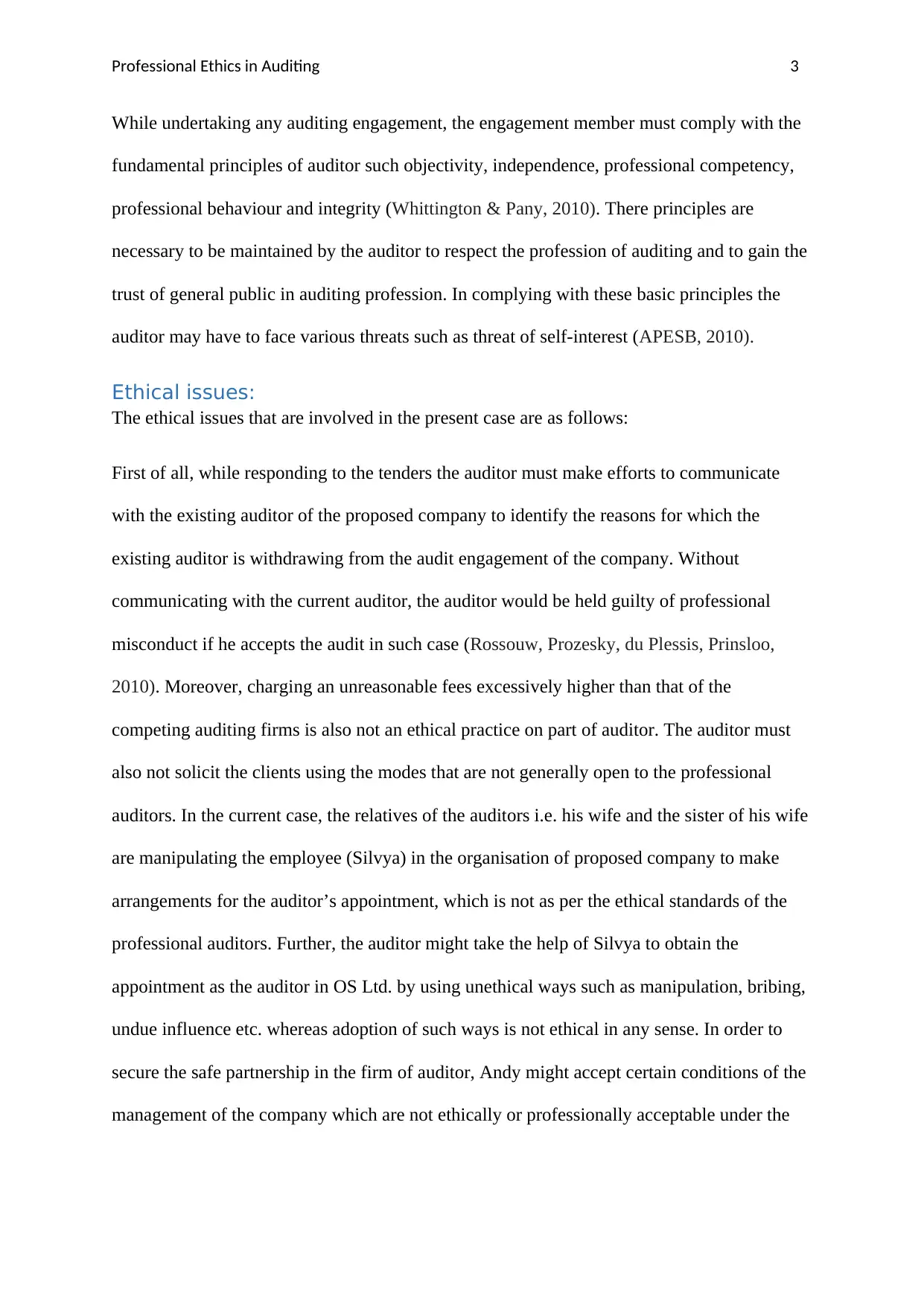
Professional Ethics in Auditing 3
While undertaking any auditing engagement, the engagement member must comply with the
fundamental principles of auditor such objectivity, independence, professional competency,
professional behaviour and integrity (Whittington & Pany, 2010). There principles are
necessary to be maintained by the auditor to respect the profession of auditing and to gain the
trust of general public in auditing profession. In complying with these basic principles the
auditor may have to face various threats such as threat of self-interest (APESB, 2010).
Ethical issues:
The ethical issues that are involved in the present case are as follows:
First of all, while responding to the tenders the auditor must make efforts to communicate
with the existing auditor of the proposed company to identify the reasons for which the
existing auditor is withdrawing from the audit engagement of the company. Without
communicating with the current auditor, the auditor would be held guilty of professional
misconduct if he accepts the audit in such case (Rossouw, Prozesky, du Plessis, Prinsloo,
2010). Moreover, charging an unreasonable fees excessively higher than that of the
competing auditing firms is also not an ethical practice on part of auditor. The auditor must
also not solicit the clients using the modes that are not generally open to the professional
auditors. In the current case, the relatives of the auditors i.e. his wife and the sister of his wife
are manipulating the employee (Silvya) in the organisation of proposed company to make
arrangements for the auditor’s appointment, which is not as per the ethical standards of the
professional auditors. Further, the auditor might take the help of Silvya to obtain the
appointment as the auditor in OS Ltd. by using unethical ways such as manipulation, bribing,
undue influence etc. whereas adoption of such ways is not ethical in any sense. In order to
secure the safe partnership in the firm of auditor, Andy might accept certain conditions of the
management of the company which are not ethically or professionally acceptable under the
While undertaking any auditing engagement, the engagement member must comply with the
fundamental principles of auditor such objectivity, independence, professional competency,
professional behaviour and integrity (Whittington & Pany, 2010). There principles are
necessary to be maintained by the auditor to respect the profession of auditing and to gain the
trust of general public in auditing profession. In complying with these basic principles the
auditor may have to face various threats such as threat of self-interest (APESB, 2010).
Ethical issues:
The ethical issues that are involved in the present case are as follows:
First of all, while responding to the tenders the auditor must make efforts to communicate
with the existing auditor of the proposed company to identify the reasons for which the
existing auditor is withdrawing from the audit engagement of the company. Without
communicating with the current auditor, the auditor would be held guilty of professional
misconduct if he accepts the audit in such case (Rossouw, Prozesky, du Plessis, Prinsloo,
2010). Moreover, charging an unreasonable fees excessively higher than that of the
competing auditing firms is also not an ethical practice on part of auditor. The auditor must
also not solicit the clients using the modes that are not generally open to the professional
auditors. In the current case, the relatives of the auditors i.e. his wife and the sister of his wife
are manipulating the employee (Silvya) in the organisation of proposed company to make
arrangements for the auditor’s appointment, which is not as per the ethical standards of the
professional auditors. Further, the auditor might take the help of Silvya to obtain the
appointment as the auditor in OS Ltd. by using unethical ways such as manipulation, bribing,
undue influence etc. whereas adoption of such ways is not ethical in any sense. In order to
secure the safe partnership in the firm of auditor, Andy might accept certain conditions of the
management of the company which are not ethically or professionally acceptable under the
Paraphrase This Document
Need a fresh take? Get an instant paraphrase of this document with our AI Paraphraser
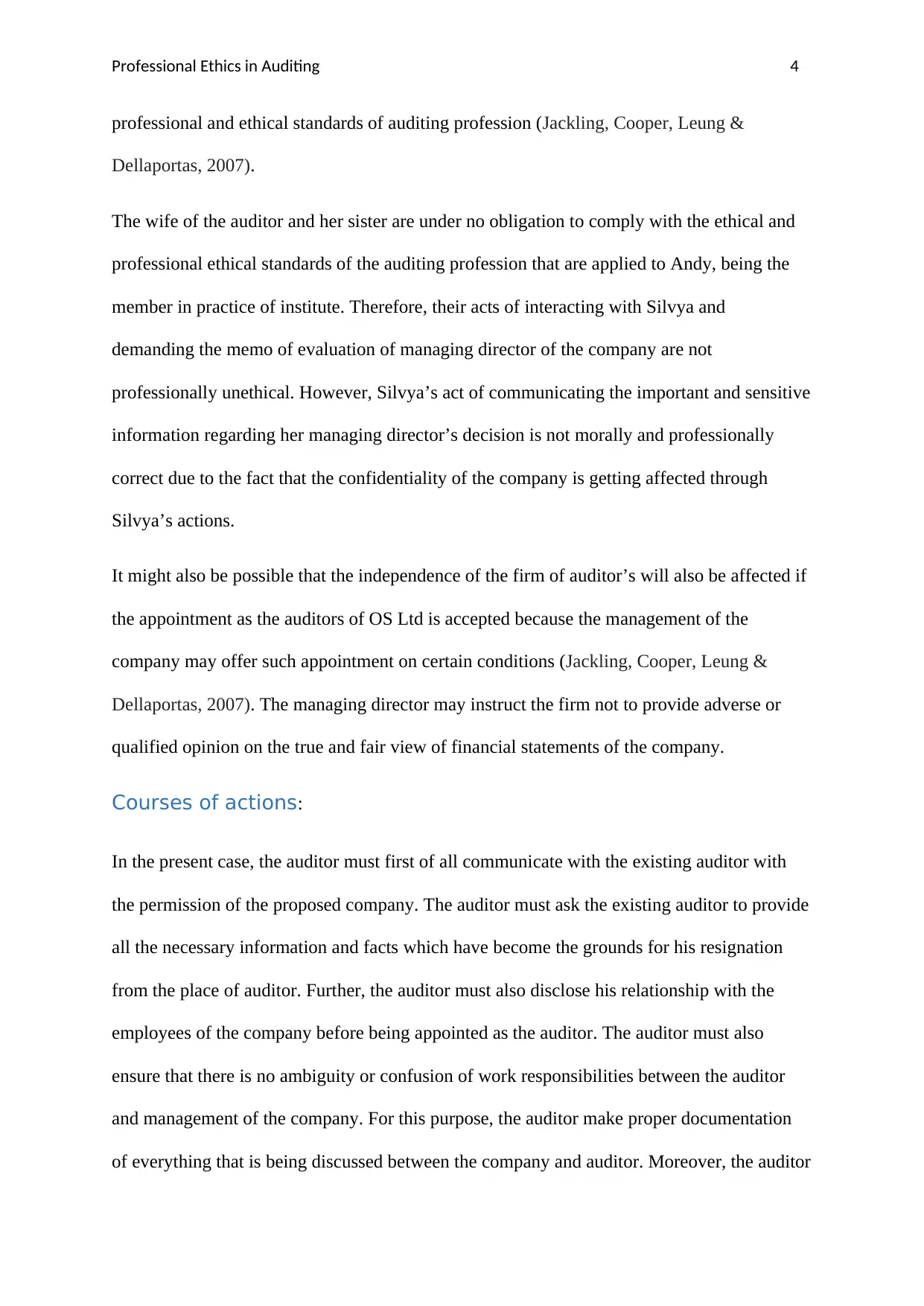
Professional Ethics in Auditing 4
professional and ethical standards of auditing profession (Jackling, Cooper, Leung &
Dellaportas, 2007).
The wife of the auditor and her sister are under no obligation to comply with the ethical and
professional ethical standards of the auditing profession that are applied to Andy, being the
member in practice of institute. Therefore, their acts of interacting with Silvya and
demanding the memo of evaluation of managing director of the company are not
professionally unethical. However, Silvya’s act of communicating the important and sensitive
information regarding her managing director’s decision is not morally and professionally
correct due to the fact that the confidentiality of the company is getting affected through
Silvya’s actions.
It might also be possible that the independence of the firm of auditor’s will also be affected if
the appointment as the auditors of OS Ltd is accepted because the management of the
company may offer such appointment on certain conditions (Jackling, Cooper, Leung &
Dellaportas, 2007). The managing director may instruct the firm not to provide adverse or
qualified opinion on the true and fair view of financial statements of the company.
Courses of actions:
In the present case, the auditor must first of all communicate with the existing auditor with
the permission of the proposed company. The auditor must ask the existing auditor to provide
all the necessary information and facts which have become the grounds for his resignation
from the place of auditor. Further, the auditor must also disclose his relationship with the
employees of the company before being appointed as the auditor. The auditor must also
ensure that there is no ambiguity or confusion of work responsibilities between the auditor
and management of the company. For this purpose, the auditor make proper documentation
of everything that is being discussed between the company and auditor. Moreover, the auditor
professional and ethical standards of auditing profession (Jackling, Cooper, Leung &
Dellaportas, 2007).
The wife of the auditor and her sister are under no obligation to comply with the ethical and
professional ethical standards of the auditing profession that are applied to Andy, being the
member in practice of institute. Therefore, their acts of interacting with Silvya and
demanding the memo of evaluation of managing director of the company are not
professionally unethical. However, Silvya’s act of communicating the important and sensitive
information regarding her managing director’s decision is not morally and professionally
correct due to the fact that the confidentiality of the company is getting affected through
Silvya’s actions.
It might also be possible that the independence of the firm of auditor’s will also be affected if
the appointment as the auditors of OS Ltd is accepted because the management of the
company may offer such appointment on certain conditions (Jackling, Cooper, Leung &
Dellaportas, 2007). The managing director may instruct the firm not to provide adverse or
qualified opinion on the true and fair view of financial statements of the company.
Courses of actions:
In the present case, the auditor must first of all communicate with the existing auditor with
the permission of the proposed company. The auditor must ask the existing auditor to provide
all the necessary information and facts which have become the grounds for his resignation
from the place of auditor. Further, the auditor must also disclose his relationship with the
employees of the company before being appointed as the auditor. The auditor must also
ensure that there is no ambiguity or confusion of work responsibilities between the auditor
and management of the company. For this purpose, the auditor make proper documentation
of everything that is being discussed between the company and auditor. Moreover, the auditor
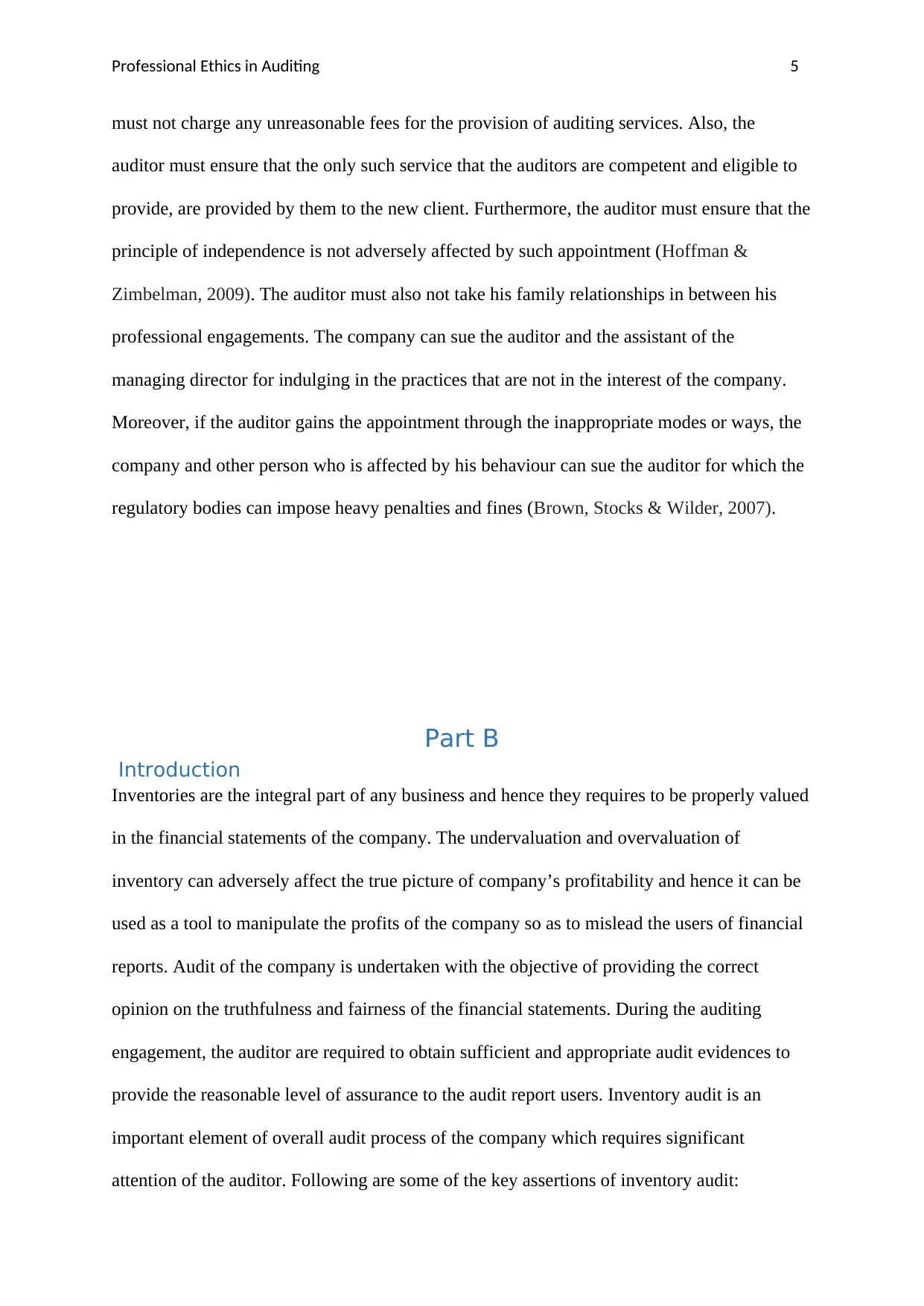
Professional Ethics in Auditing 5
must not charge any unreasonable fees for the provision of auditing services. Also, the
auditor must ensure that the only such service that the auditors are competent and eligible to
provide, are provided by them to the new client. Furthermore, the auditor must ensure that the
principle of independence is not adversely affected by such appointment (Hoffman &
Zimbelman, 2009). The auditor must also not take his family relationships in between his
professional engagements. The company can sue the auditor and the assistant of the
managing director for indulging in the practices that are not in the interest of the company.
Moreover, if the auditor gains the appointment through the inappropriate modes or ways, the
company and other person who is affected by his behaviour can sue the auditor for which the
regulatory bodies can impose heavy penalties and fines (Brown, Stocks & Wilder, 2007).
Part B
Introduction
Inventories are the integral part of any business and hence they requires to be properly valued
in the financial statements of the company. The undervaluation and overvaluation of
inventory can adversely affect the true picture of company’s profitability and hence it can be
used as a tool to manipulate the profits of the company so as to mislead the users of financial
reports. Audit of the company is undertaken with the objective of providing the correct
opinion on the truthfulness and fairness of the financial statements. During the auditing
engagement, the auditor are required to obtain sufficient and appropriate audit evidences to
provide the reasonable level of assurance to the audit report users. Inventory audit is an
important element of overall audit process of the company which requires significant
attention of the auditor. Following are some of the key assertions of inventory audit:
must not charge any unreasonable fees for the provision of auditing services. Also, the
auditor must ensure that the only such service that the auditors are competent and eligible to
provide, are provided by them to the new client. Furthermore, the auditor must ensure that the
principle of independence is not adversely affected by such appointment (Hoffman &
Zimbelman, 2009). The auditor must also not take his family relationships in between his
professional engagements. The company can sue the auditor and the assistant of the
managing director for indulging in the practices that are not in the interest of the company.
Moreover, if the auditor gains the appointment through the inappropriate modes or ways, the
company and other person who is affected by his behaviour can sue the auditor for which the
regulatory bodies can impose heavy penalties and fines (Brown, Stocks & Wilder, 2007).
Part B
Introduction
Inventories are the integral part of any business and hence they requires to be properly valued
in the financial statements of the company. The undervaluation and overvaluation of
inventory can adversely affect the true picture of company’s profitability and hence it can be
used as a tool to manipulate the profits of the company so as to mislead the users of financial
reports. Audit of the company is undertaken with the objective of providing the correct
opinion on the truthfulness and fairness of the financial statements. During the auditing
engagement, the auditor are required to obtain sufficient and appropriate audit evidences to
provide the reasonable level of assurance to the audit report users. Inventory audit is an
important element of overall audit process of the company which requires significant
attention of the auditor. Following are some of the key assertions of inventory audit:
⊘ This is a preview!⊘
Do you want full access?
Subscribe today to unlock all pages.

Trusted by 1+ million students worldwide
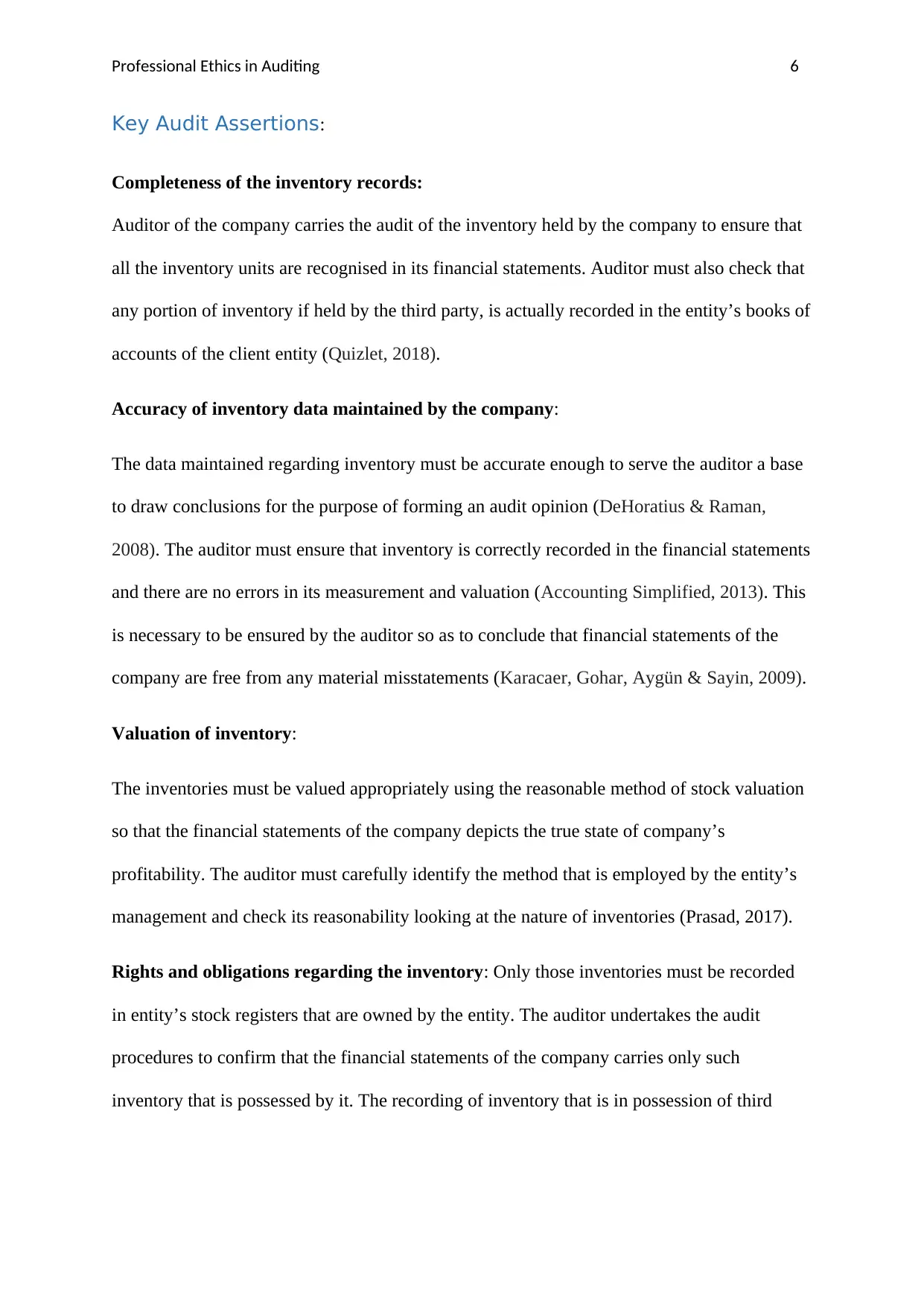
Professional Ethics in Auditing 6
Key Audit Assertions:
Completeness of the inventory records:
Auditor of the company carries the audit of the inventory held by the company to ensure that
all the inventory units are recognised in its financial statements. Auditor must also check that
any portion of inventory if held by the third party, is actually recorded in the entity’s books of
accounts of the client entity (Quizlet, 2018).
Accuracy of inventory data maintained by the company:
The data maintained regarding inventory must be accurate enough to serve the auditor a base
to draw conclusions for the purpose of forming an audit opinion (DeHoratius & Raman,
2008). The auditor must ensure that inventory is correctly recorded in the financial statements
and there are no errors in its measurement and valuation (Accounting Simplified, 2013). This
is necessary to be ensured by the auditor so as to conclude that financial statements of the
company are free from any material misstatements (Karacaer, Gohar, Aygün & Sayin, 2009).
Valuation of inventory:
The inventories must be valued appropriately using the reasonable method of stock valuation
so that the financial statements of the company depicts the true state of company’s
profitability. The auditor must carefully identify the method that is employed by the entity’s
management and check its reasonability looking at the nature of inventories (Prasad, 2017).
Rights and obligations regarding the inventory: Only those inventories must be recorded
in entity’s stock registers that are owned by the entity. The auditor undertakes the audit
procedures to confirm that the financial statements of the company carries only such
inventory that is possessed by it. The recording of inventory that is in possession of third
Key Audit Assertions:
Completeness of the inventory records:
Auditor of the company carries the audit of the inventory held by the company to ensure that
all the inventory units are recognised in its financial statements. Auditor must also check that
any portion of inventory if held by the third party, is actually recorded in the entity’s books of
accounts of the client entity (Quizlet, 2018).
Accuracy of inventory data maintained by the company:
The data maintained regarding inventory must be accurate enough to serve the auditor a base
to draw conclusions for the purpose of forming an audit opinion (DeHoratius & Raman,
2008). The auditor must ensure that inventory is correctly recorded in the financial statements
and there are no errors in its measurement and valuation (Accounting Simplified, 2013). This
is necessary to be ensured by the auditor so as to conclude that financial statements of the
company are free from any material misstatements (Karacaer, Gohar, Aygün & Sayin, 2009).
Valuation of inventory:
The inventories must be valued appropriately using the reasonable method of stock valuation
so that the financial statements of the company depicts the true state of company’s
profitability. The auditor must carefully identify the method that is employed by the entity’s
management and check its reasonability looking at the nature of inventories (Prasad, 2017).
Rights and obligations regarding the inventory: Only those inventories must be recorded
in entity’s stock registers that are owned by the entity. The auditor undertakes the audit
procedures to confirm that the financial statements of the company carries only such
inventory that is possessed by it. The recording of inventory that is in possession of third
Paraphrase This Document
Need a fresh take? Get an instant paraphrase of this document with our AI Paraphraser
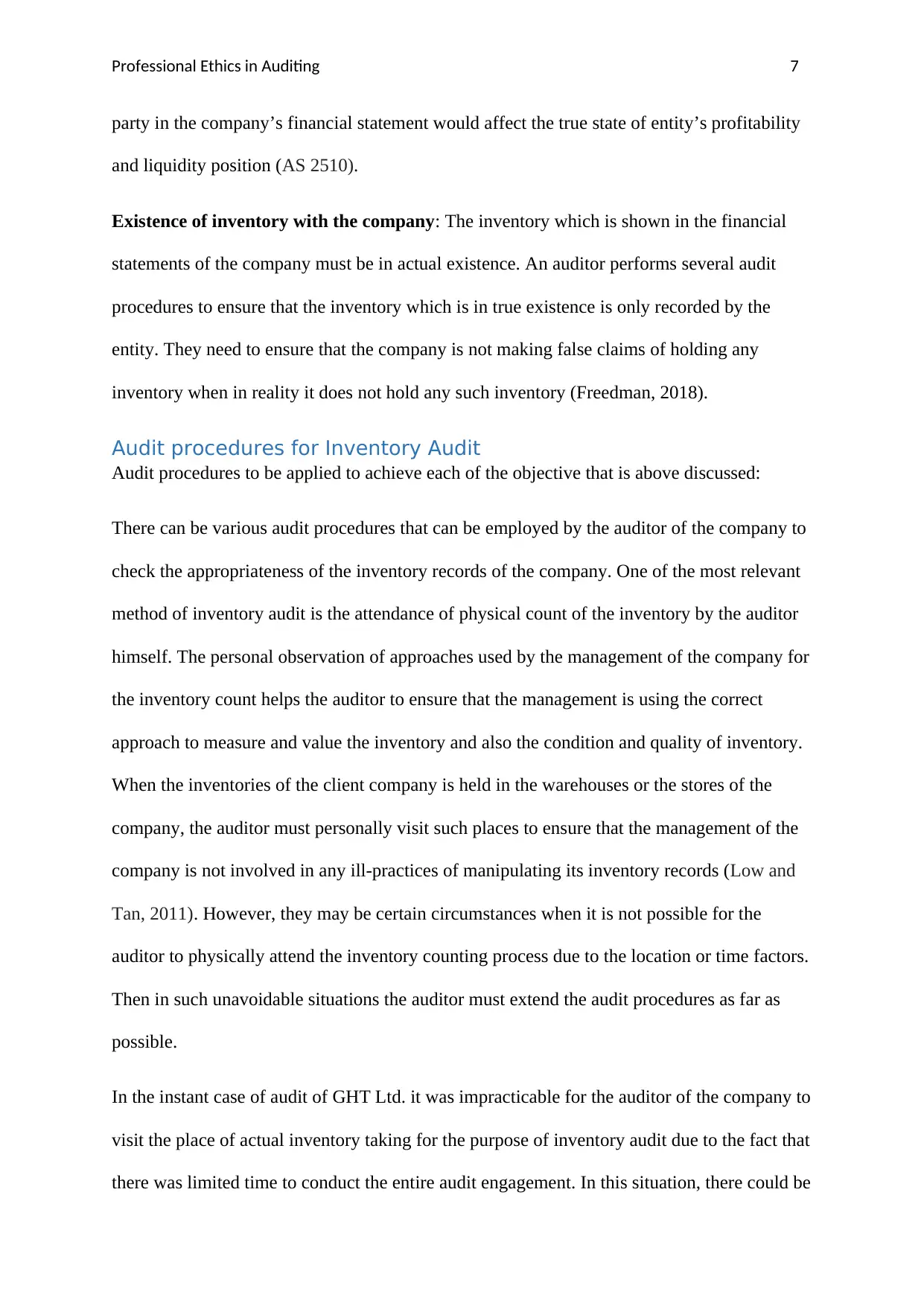
Professional Ethics in Auditing 7
party in the company’s financial statement would affect the true state of entity’s profitability
and liquidity position (AS 2510).
Existence of inventory with the company: The inventory which is shown in the financial
statements of the company must be in actual existence. An auditor performs several audit
procedures to ensure that the inventory which is in true existence is only recorded by the
entity. They need to ensure that the company is not making false claims of holding any
inventory when in reality it does not hold any such inventory (Freedman, 2018).
Audit procedures for Inventory Audit
Audit procedures to be applied to achieve each of the objective that is above discussed:
There can be various audit procedures that can be employed by the auditor of the company to
check the appropriateness of the inventory records of the company. One of the most relevant
method of inventory audit is the attendance of physical count of the inventory by the auditor
himself. The personal observation of approaches used by the management of the company for
the inventory count helps the auditor to ensure that the management is using the correct
approach to measure and value the inventory and also the condition and quality of inventory.
When the inventories of the client company is held in the warehouses or the stores of the
company, the auditor must personally visit such places to ensure that the management of the
company is not involved in any ill-practices of manipulating its inventory records (Low and
Tan, 2011). However, they may be certain circumstances when it is not possible for the
auditor to physically attend the inventory counting process due to the location or time factors.
Then in such unavoidable situations the auditor must extend the audit procedures as far as
possible.
In the instant case of audit of GHT Ltd. it was impracticable for the auditor of the company to
visit the place of actual inventory taking for the purpose of inventory audit due to the fact that
there was limited time to conduct the entire audit engagement. In this situation, there could be
party in the company’s financial statement would affect the true state of entity’s profitability
and liquidity position (AS 2510).
Existence of inventory with the company: The inventory which is shown in the financial
statements of the company must be in actual existence. An auditor performs several audit
procedures to ensure that the inventory which is in true existence is only recorded by the
entity. They need to ensure that the company is not making false claims of holding any
inventory when in reality it does not hold any such inventory (Freedman, 2018).
Audit procedures for Inventory Audit
Audit procedures to be applied to achieve each of the objective that is above discussed:
There can be various audit procedures that can be employed by the auditor of the company to
check the appropriateness of the inventory records of the company. One of the most relevant
method of inventory audit is the attendance of physical count of the inventory by the auditor
himself. The personal observation of approaches used by the management of the company for
the inventory count helps the auditor to ensure that the management is using the correct
approach to measure and value the inventory and also the condition and quality of inventory.
When the inventories of the client company is held in the warehouses or the stores of the
company, the auditor must personally visit such places to ensure that the management of the
company is not involved in any ill-practices of manipulating its inventory records (Low and
Tan, 2011). However, they may be certain circumstances when it is not possible for the
auditor to physically attend the inventory counting process due to the location or time factors.
Then in such unavoidable situations the auditor must extend the audit procedures as far as
possible.
In the instant case of audit of GHT Ltd. it was impracticable for the auditor of the company to
visit the place of actual inventory taking for the purpose of inventory audit due to the fact that
there was limited time to conduct the entire audit engagement. In this situation, there could be
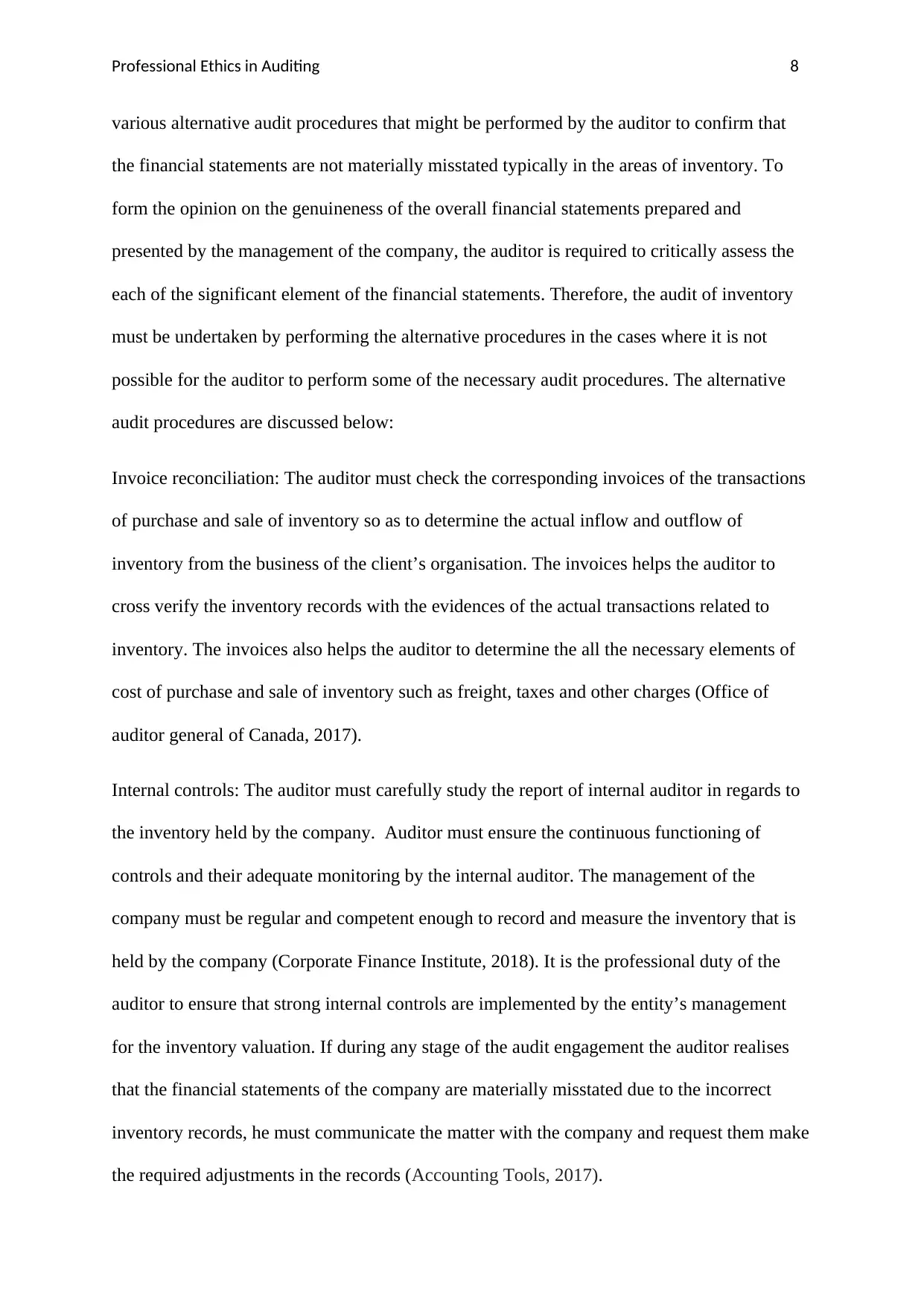
Professional Ethics in Auditing 8
various alternative audit procedures that might be performed by the auditor to confirm that
the financial statements are not materially misstated typically in the areas of inventory. To
form the opinion on the genuineness of the overall financial statements prepared and
presented by the management of the company, the auditor is required to critically assess the
each of the significant element of the financial statements. Therefore, the audit of inventory
must be undertaken by performing the alternative procedures in the cases where it is not
possible for the auditor to perform some of the necessary audit procedures. The alternative
audit procedures are discussed below:
Invoice reconciliation: The auditor must check the corresponding invoices of the transactions
of purchase and sale of inventory so as to determine the actual inflow and outflow of
inventory from the business of the client’s organisation. The invoices helps the auditor to
cross verify the inventory records with the evidences of the actual transactions related to
inventory. The invoices also helps the auditor to determine the all the necessary elements of
cost of purchase and sale of inventory such as freight, taxes and other charges (Office of
auditor general of Canada, 2017).
Internal controls: The auditor must carefully study the report of internal auditor in regards to
the inventory held by the company. Auditor must ensure the continuous functioning of
controls and their adequate monitoring by the internal auditor. The management of the
company must be regular and competent enough to record and measure the inventory that is
held by the company (Corporate Finance Institute, 2018). It is the professional duty of the
auditor to ensure that strong internal controls are implemented by the entity’s management
for the inventory valuation. If during any stage of the audit engagement the auditor realises
that the financial statements of the company are materially misstated due to the incorrect
inventory records, he must communicate the matter with the company and request them make
the required adjustments in the records (Accounting Tools, 2017).
various alternative audit procedures that might be performed by the auditor to confirm that
the financial statements are not materially misstated typically in the areas of inventory. To
form the opinion on the genuineness of the overall financial statements prepared and
presented by the management of the company, the auditor is required to critically assess the
each of the significant element of the financial statements. Therefore, the audit of inventory
must be undertaken by performing the alternative procedures in the cases where it is not
possible for the auditor to perform some of the necessary audit procedures. The alternative
audit procedures are discussed below:
Invoice reconciliation: The auditor must check the corresponding invoices of the transactions
of purchase and sale of inventory so as to determine the actual inflow and outflow of
inventory from the business of the client’s organisation. The invoices helps the auditor to
cross verify the inventory records with the evidences of the actual transactions related to
inventory. The invoices also helps the auditor to determine the all the necessary elements of
cost of purchase and sale of inventory such as freight, taxes and other charges (Office of
auditor general of Canada, 2017).
Internal controls: The auditor must carefully study the report of internal auditor in regards to
the inventory held by the company. Auditor must ensure the continuous functioning of
controls and their adequate monitoring by the internal auditor. The management of the
company must be regular and competent enough to record and measure the inventory that is
held by the company (Corporate Finance Institute, 2018). It is the professional duty of the
auditor to ensure that strong internal controls are implemented by the entity’s management
for the inventory valuation. If during any stage of the audit engagement the auditor realises
that the financial statements of the company are materially misstated due to the incorrect
inventory records, he must communicate the matter with the company and request them make
the required adjustments in the records (Accounting Tools, 2017).
⊘ This is a preview!⊘
Do you want full access?
Subscribe today to unlock all pages.

Trusted by 1+ million students worldwide
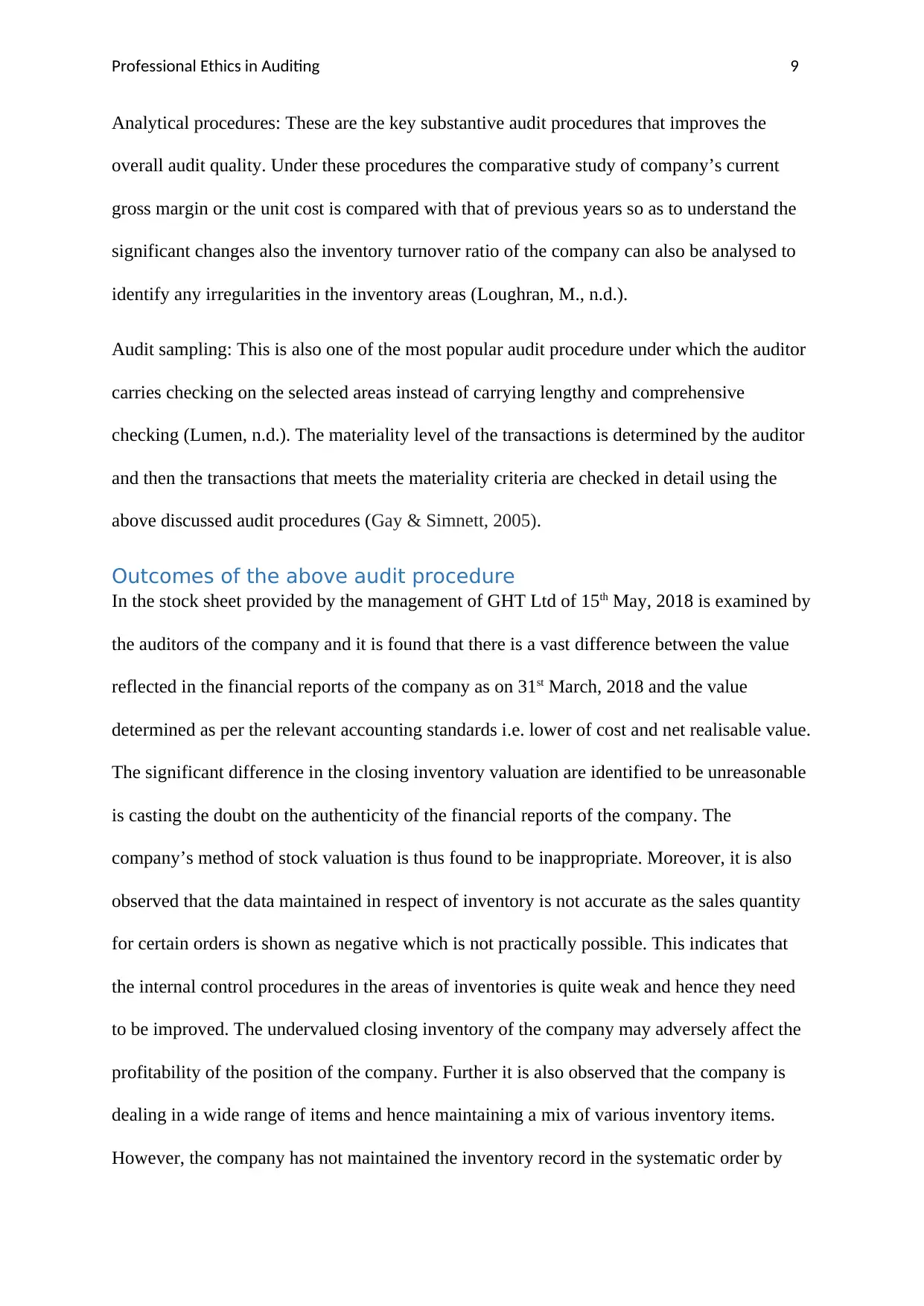
Professional Ethics in Auditing 9
Analytical procedures: These are the key substantive audit procedures that improves the
overall audit quality. Under these procedures the comparative study of company’s current
gross margin or the unit cost is compared with that of previous years so as to understand the
significant changes also the inventory turnover ratio of the company can also be analysed to
identify any irregularities in the inventory areas (Loughran, M., n.d.).
Audit sampling: This is also one of the most popular audit procedure under which the auditor
carries checking on the selected areas instead of carrying lengthy and comprehensive
checking (Lumen, n.d.). The materiality level of the transactions is determined by the auditor
and then the transactions that meets the materiality criteria are checked in detail using the
above discussed audit procedures (Gay & Simnett, 2005).
Outcomes of the above audit procedure
In the stock sheet provided by the management of GHT Ltd of 15th May, 2018 is examined by
the auditors of the company and it is found that there is a vast difference between the value
reflected in the financial reports of the company as on 31st March, 2018 and the value
determined as per the relevant accounting standards i.e. lower of cost and net realisable value.
The significant difference in the closing inventory valuation are identified to be unreasonable
is casting the doubt on the authenticity of the financial reports of the company. The
company’s method of stock valuation is thus found to be inappropriate. Moreover, it is also
observed that the data maintained in respect of inventory is not accurate as the sales quantity
for certain orders is shown as negative which is not practically possible. This indicates that
the internal control procedures in the areas of inventories is quite weak and hence they need
to be improved. The undervalued closing inventory of the company may adversely affect the
profitability of the position of the company. Further it is also observed that the company is
dealing in a wide range of items and hence maintaining a mix of various inventory items.
However, the company has not maintained the inventory record in the systematic order by
Analytical procedures: These are the key substantive audit procedures that improves the
overall audit quality. Under these procedures the comparative study of company’s current
gross margin or the unit cost is compared with that of previous years so as to understand the
significant changes also the inventory turnover ratio of the company can also be analysed to
identify any irregularities in the inventory areas (Loughran, M., n.d.).
Audit sampling: This is also one of the most popular audit procedure under which the auditor
carries checking on the selected areas instead of carrying lengthy and comprehensive
checking (Lumen, n.d.). The materiality level of the transactions is determined by the auditor
and then the transactions that meets the materiality criteria are checked in detail using the
above discussed audit procedures (Gay & Simnett, 2005).
Outcomes of the above audit procedure
In the stock sheet provided by the management of GHT Ltd of 15th May, 2018 is examined by
the auditors of the company and it is found that there is a vast difference between the value
reflected in the financial reports of the company as on 31st March, 2018 and the value
determined as per the relevant accounting standards i.e. lower of cost and net realisable value.
The significant difference in the closing inventory valuation are identified to be unreasonable
is casting the doubt on the authenticity of the financial reports of the company. The
company’s method of stock valuation is thus found to be inappropriate. Moreover, it is also
observed that the data maintained in respect of inventory is not accurate as the sales quantity
for certain orders is shown as negative which is not practically possible. This indicates that
the internal control procedures in the areas of inventories is quite weak and hence they need
to be improved. The undervalued closing inventory of the company may adversely affect the
profitability of the position of the company. Further it is also observed that the company is
dealing in a wide range of items and hence maintaining a mix of various inventory items.
However, the company has not maintained the inventory record in the systematic order by
Paraphrase This Document
Need a fresh take? Get an instant paraphrase of this document with our AI Paraphraser
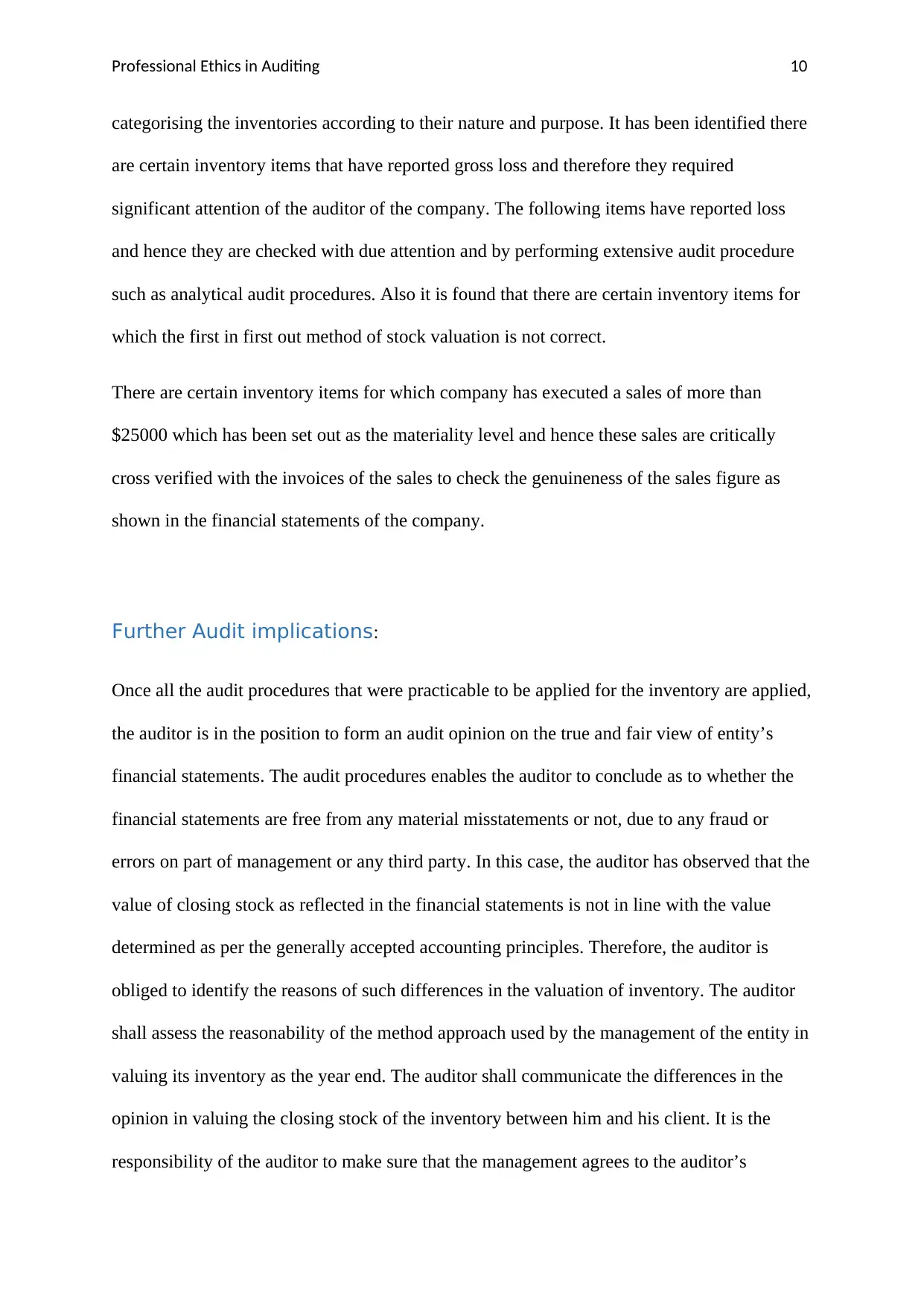
Professional Ethics in Auditing 10
categorising the inventories according to their nature and purpose. It has been identified there
are certain inventory items that have reported gross loss and therefore they required
significant attention of the auditor of the company. The following items have reported loss
and hence they are checked with due attention and by performing extensive audit procedure
such as analytical audit procedures. Also it is found that there are certain inventory items for
which the first in first out method of stock valuation is not correct.
There are certain inventory items for which company has executed a sales of more than
$25000 which has been set out as the materiality level and hence these sales are critically
cross verified with the invoices of the sales to check the genuineness of the sales figure as
shown in the financial statements of the company.
Further Audit implications:
Once all the audit procedures that were practicable to be applied for the inventory are applied,
the auditor is in the position to form an audit opinion on the true and fair view of entity’s
financial statements. The audit procedures enables the auditor to conclude as to whether the
financial statements are free from any material misstatements or not, due to any fraud or
errors on part of management or any third party. In this case, the auditor has observed that the
value of closing stock as reflected in the financial statements is not in line with the value
determined as per the generally accepted accounting principles. Therefore, the auditor is
obliged to identify the reasons of such differences in the valuation of inventory. The auditor
shall assess the reasonability of the method approach used by the management of the entity in
valuing its inventory as the year end. The auditor shall communicate the differences in the
opinion in valuing the closing stock of the inventory between him and his client. It is the
responsibility of the auditor to make sure that the management agrees to the auditor’s
categorising the inventories according to their nature and purpose. It has been identified there
are certain inventory items that have reported gross loss and therefore they required
significant attention of the auditor of the company. The following items have reported loss
and hence they are checked with due attention and by performing extensive audit procedure
such as analytical audit procedures. Also it is found that there are certain inventory items for
which the first in first out method of stock valuation is not correct.
There are certain inventory items for which company has executed a sales of more than
$25000 which has been set out as the materiality level and hence these sales are critically
cross verified with the invoices of the sales to check the genuineness of the sales figure as
shown in the financial statements of the company.
Further Audit implications:
Once all the audit procedures that were practicable to be applied for the inventory are applied,
the auditor is in the position to form an audit opinion on the true and fair view of entity’s
financial statements. The audit procedures enables the auditor to conclude as to whether the
financial statements are free from any material misstatements or not, due to any fraud or
errors on part of management or any third party. In this case, the auditor has observed that the
value of closing stock as reflected in the financial statements is not in line with the value
determined as per the generally accepted accounting principles. Therefore, the auditor is
obliged to identify the reasons of such differences in the valuation of inventory. The auditor
shall assess the reasonability of the method approach used by the management of the entity in
valuing its inventory as the year end. The auditor shall communicate the differences in the
opinion in valuing the closing stock of the inventory between him and his client. It is the
responsibility of the auditor to make sure that the management agrees to the auditor’s
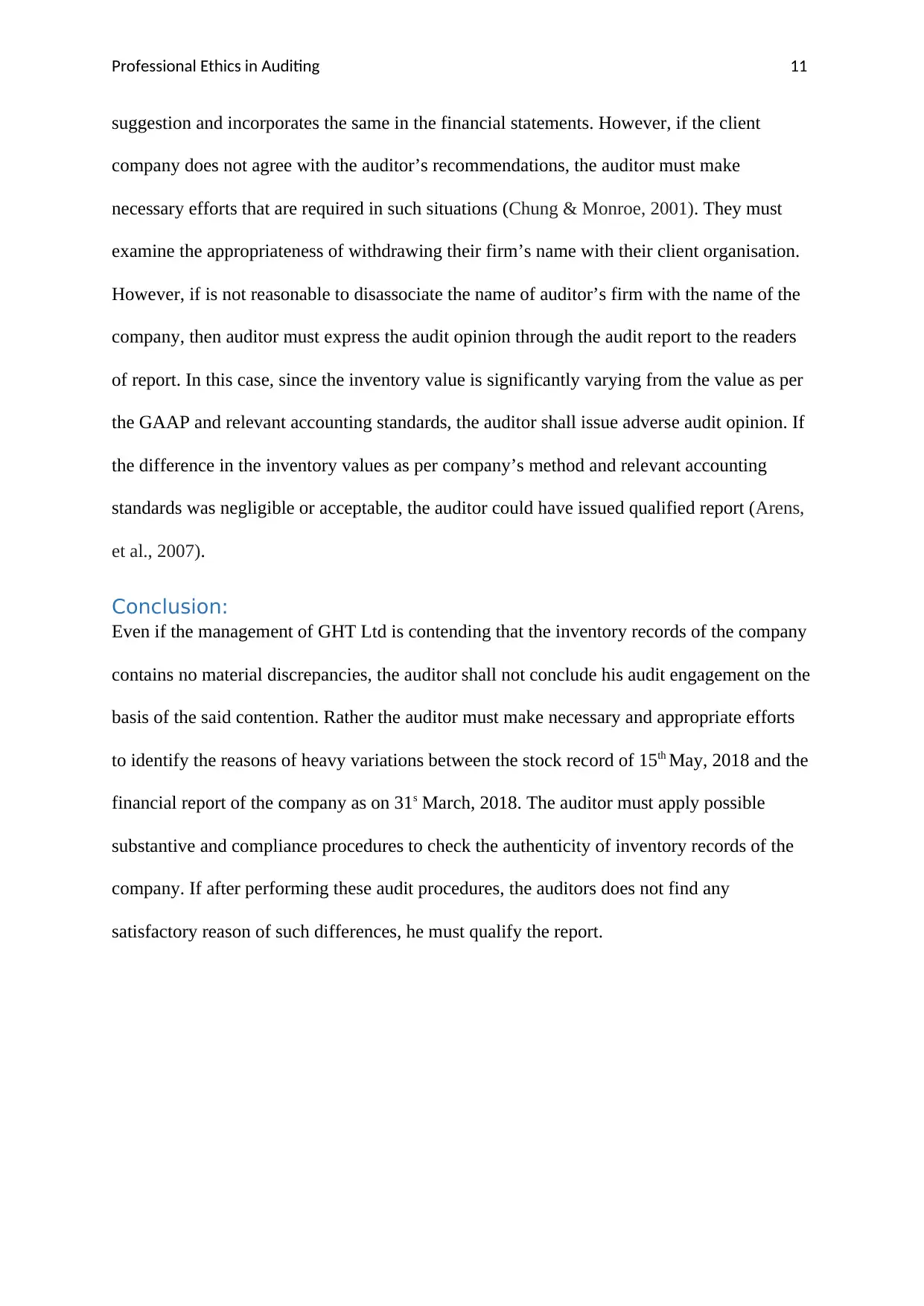
Professional Ethics in Auditing 11
suggestion and incorporates the same in the financial statements. However, if the client
company does not agree with the auditor’s recommendations, the auditor must make
necessary efforts that are required in such situations (Chung & Monroe, 2001). They must
examine the appropriateness of withdrawing their firm’s name with their client organisation.
However, if is not reasonable to disassociate the name of auditor’s firm with the name of the
company, then auditor must express the audit opinion through the audit report to the readers
of report. In this case, since the inventory value is significantly varying from the value as per
the GAAP and relevant accounting standards, the auditor shall issue adverse audit opinion. If
the difference in the inventory values as per company’s method and relevant accounting
standards was negligible or acceptable, the auditor could have issued qualified report (Arens,
et al., 2007).
Conclusion:
Even if the management of GHT Ltd is contending that the inventory records of the company
contains no material discrepancies, the auditor shall not conclude his audit engagement on the
basis of the said contention. Rather the auditor must make necessary and appropriate efforts
to identify the reasons of heavy variations between the stock record of 15th May, 2018 and the
financial report of the company as on 31s March, 2018. The auditor must apply possible
substantive and compliance procedures to check the authenticity of inventory records of the
company. If after performing these audit procedures, the auditors does not find any
satisfactory reason of such differences, he must qualify the report.
suggestion and incorporates the same in the financial statements. However, if the client
company does not agree with the auditor’s recommendations, the auditor must make
necessary efforts that are required in such situations (Chung & Monroe, 2001). They must
examine the appropriateness of withdrawing their firm’s name with their client organisation.
However, if is not reasonable to disassociate the name of auditor’s firm with the name of the
company, then auditor must express the audit opinion through the audit report to the readers
of report. In this case, since the inventory value is significantly varying from the value as per
the GAAP and relevant accounting standards, the auditor shall issue adverse audit opinion. If
the difference in the inventory values as per company’s method and relevant accounting
standards was negligible or acceptable, the auditor could have issued qualified report (Arens,
et al., 2007).
Conclusion:
Even if the management of GHT Ltd is contending that the inventory records of the company
contains no material discrepancies, the auditor shall not conclude his audit engagement on the
basis of the said contention. Rather the auditor must make necessary and appropriate efforts
to identify the reasons of heavy variations between the stock record of 15th May, 2018 and the
financial report of the company as on 31s March, 2018. The auditor must apply possible
substantive and compliance procedures to check the authenticity of inventory records of the
company. If after performing these audit procedures, the auditors does not find any
satisfactory reason of such differences, he must qualify the report.
⊘ This is a preview!⊘
Do you want full access?
Subscribe today to unlock all pages.

Trusted by 1+ million students worldwide
1 out of 30
Related Documents
Your All-in-One AI-Powered Toolkit for Academic Success.
+13062052269
info@desklib.com
Available 24*7 on WhatsApp / Email
![[object Object]](/_next/static/media/star-bottom.7253800d.svg)
Unlock your academic potential
Copyright © 2020–2025 A2Z Services. All Rights Reserved. Developed and managed by ZUCOL.





